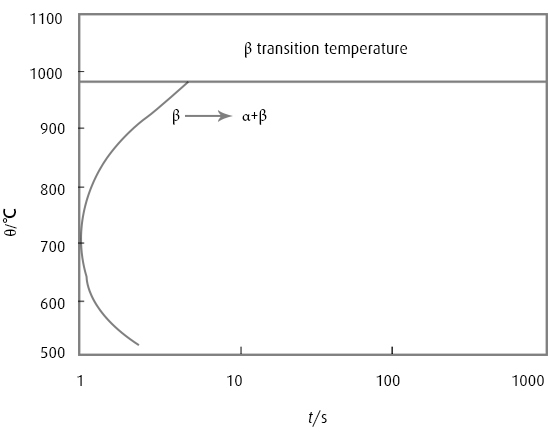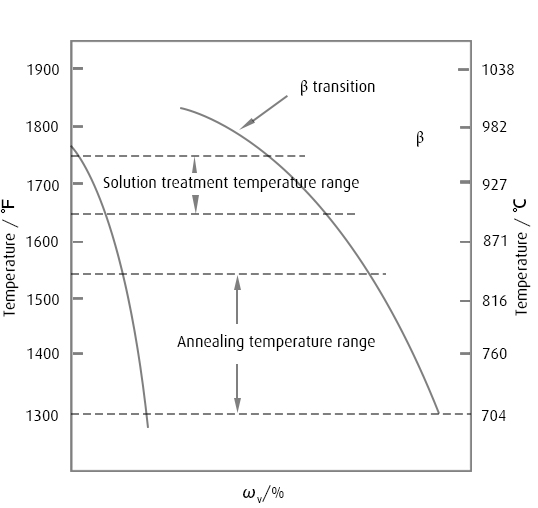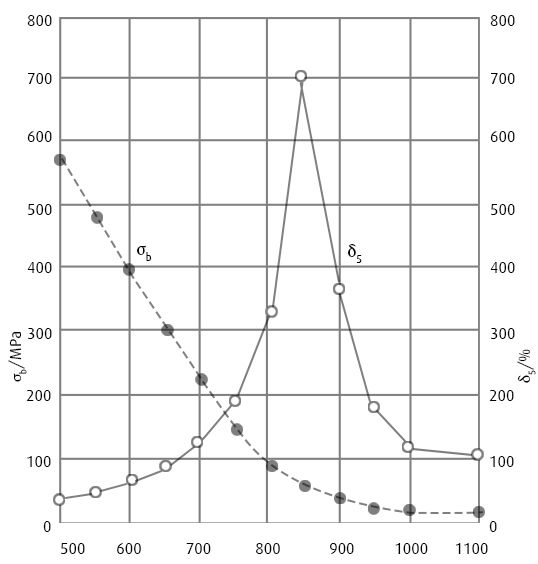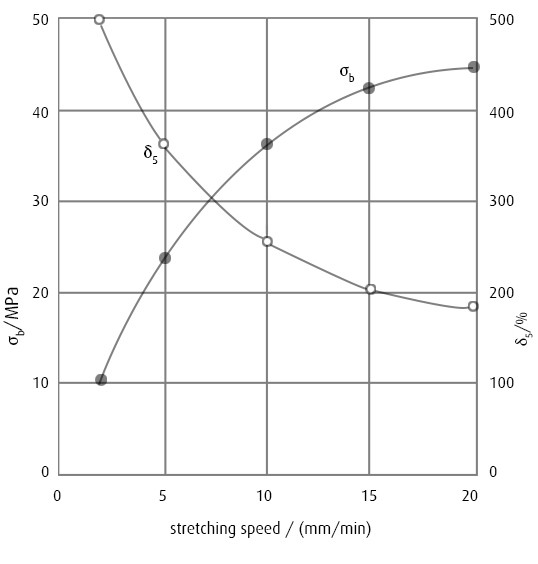Ti-6Al-4V(Grade 5)
The main characteristics of Titanium Ti-6Al-4V (Grade 5) are excellent comprehensive properties and good process characteristics. Titanium Grade 5 has medium room temperature and high temperature strength, good creep resistance and thermal stability, high fatigue performance and crack growth resistance in seawater, as well as comfortable fracture toughness and hot salt stress corrosion performance, and it is sensitive to hydrogen. The performance is also lower than that of Ti-2Al-1.5Mn and Ti-4Al-1.5Mn alloys, and it is suitable for manufacturing various parts that work in a wide temperature range from -196 to 450°C, especially those designed with the principle of damage tolerance.
Ti-6Al-4V also has excellent process plasticity and superplasticity, and is suitable for forming by various pressure processing methods, and adopts various methods for welding and mechanical processing.
The main semi-finished forms of Ti-6Al-4V are bars, forgings, thin plates, thick plates, profiles and wires, etc. It can also be used for castings (ZTC4).
Titanium alloys are mainly used in the annealed state, and can also be strengthened by solution aging treatment to a certain extent, but the hardened cross-section generally does not exceed 25~30mm.
| Thermal conductivity of Ti-6Al-4V(Ti Gr.5) | ||||||
| θ/℃ | 20 | 100 | 200 | 300 | 400 | 500 |
| λ/W·m-1·K-1 | 6.8 | 7.4 | 8.7 | 9.8 | 10.3 | 11.8 |
| Specific heat capacity of Ti-6Al-4V(Ti Gr.5) | ||||||
| θ/℃ | 20 | 100 | 200 | 300 | 400 | 500 |
| с/J·kg-1·K-1 | 611 | 624 | 653 | 674 | 691 | 703 |
| Linear Expansion Coefficient of Ti-6Al-4V(Ti Gr.5) | ||||||
| θ/℃ | 20~100 | 20~200 | 20~300 | 20~400 | 20~500 | 20~600 |
| α/10-6K-1 | 9.1 | 9.2 | 9.3 | 9.5 | 9.7 | 10 |
| Resistivity of Ti-6Al-4V(Ti Gr.5) | ||||||||||
| θ/℃ | 20 | 100 | 200 | 300 | 400 | 500 | 550 | 600 | 700 | 800 |
| ρ/μΩ·m | 1.7 | 1.76 | 1.82 | 1.86 | 1.89 | 1.91 | 1.92 | 1.92 | 1.92 | 1.91 |
Titanium Grade 5 chemical composition (mass fraction) %
| Grade | Alloy Element | Impurities≤ | ||||||||
| Ti | Al | V | Fe | C | N | H | O | Other Element | ||
| Single | Total | |||||||||
| Ti Gr5 | Balance | 5.5~6.8 | 3.5~4.5 | 0.3 | 0.1 | 0.05 | 0.015 | 0.2 | 0.1 | 0.4 |
Features of Ti-6Al-4V(Ti Gr.5)
| Alloy Type | Grade | Chemical Composition | Operating Temperature /℃ | Intensity Level /MPa | Features and Applications |
| α+β | Gr.5 | Ti-6Al-4V | 400 | ≥895 | It is a medium-strength α+β type titanium alloy with excellent comprehensive properties and good thermal processing performance, which is the most widely used in the aerospace industry. It can work for a long time at 400℃. It is suitable for the manufacture of fan and compressor discs and blades of aero-engines, as well as parts such as frames and joints of aircraft. For -196℃ low temperature parts. |
Anti-oxidant properties of Ti-6Al-4V(Ti Gr.5)
Ti-6Al-4V is heated below 430 ℃ for a long time to form a thin and protective oxide film. As the heating temperature increases, the oxide film thickens and its protection becomes poor. After the alloy was heated at 700 °C for 2 h, the thickness of the oxide film reached 25 μm. Heating at temperatures above 800°C forms a loose oxide layer. After heating at 1000 °C for 1 h, the thickness of the oxide layer reached 0.65 mm.
Magnetic properties of Ti-6Al-4V(Ti Gr.5)
Non-magnetic.
Magnetic permeability μ=1.00005 H/m under the condition of 1592 A/m magnetic field strength
Forms of Titanium Grade 5 We Can Provide
Phase Transformation and Microstructure of Ti-6Al-4V(Ti Gr.5)
phase transition
1) Phase transition temperature α+β↔β transition temperature is 995℃±15℃ and 975℃±15℃ (ELI)
2) Time-temperature-structure transformation curve
3) Recrystallization transition temperature
Start: 850°C; End: 950°C

Microstructure of Ti-6Al-4V(Ti Gr.5)
1) The vertical section of the Ti-Al-V ternary system with an Al content of 6% and the position of Ti-6Al-4V in the figure.
Ti-6Al-4V is composed of α and β phases in equilibrium at room temperature, and the content of β phase is generally 8% to 10%.

2) When Ti-6Al-4V is rapidly cooled from the β phase region, a supersaturated martensite α' phase is obtained. The primary α and α' phases are obtained when rapidly cooled from the upper part of the α+β phase region, accompanied by a small amount of metastable retained β phase.
When rapidly cooling below the martensitic transformation start temperature (Ms) in the α+β phase region (such as 900°C), primary α phase + α' phase and retained β phase are obtained.
When rapidly cooled at a lower temperature (such as 840 °C), the primary α phase and the metastable β phase are obtained during the aging process, and the above α' and retained β phases are both decomposed into α+β phases.
3) When Ti-6Al-4V is cooled in air from the upper part of the α+β phase region, primary α phase, flaky secondary α phase and a small amount of retained β phase are obtained (the mixture of flaky secondary α phase and retained β phase is usually called transform beta tissue). Ti-6Al-4V semi-finished products that have undergone thermal deformation in the upper part of the α+β phase region usually have this microstructure, which is characterized by a certain number of primary α phases distributed on the transformed β structure matrix. This microstructure is often referred to as a two-state structure, which has better comprehensive mechanical properties.
4) The content of primary α phase has obvious influence on the mechanical properties of Ti-6Al-4V. Generally speaking, when the content of primary α phase is large, the tensile plasticity and fatigue properties at room temperature are better; when the amount of primary α phase is small, the high temperature durability, creep performance and fracture toughness are better. In order to obtain excellent comprehensive mechanical properties, the content of primary α phase is usually expected to be controlled within the range of 15% to 50%. When the primary α phase content exceeds this range, it is allowed to add a high temperature solution treatment before normal annealing, that is, keep the temperature at 30~60 °C below the β transformation temperature for 1 h, and then air or water cooling.
Manufacturing process and performance of Ti-6Al-4V(Ti Gr.5)
1) ordinary annealing
Plate and plate parts: 700~850℃, 0.5~2h, air cooling
Bars and forgings: 700~850℃, 1~2h, air cooling
A gas-saturated layer forms on the surface of the part during annealing in air. Therefore, dimensional allowances should be pre-specified in order to remove the gas-saturated layer by chemical etching or machining (grinding). The following table lists the thickness of the gas-saturated layer formed when Ti-6Al-4V is heated at different temperatures.
| Thickness of gas saturation layer formed when Ti-6Al-4V heated at different temperatures mm | ||||||
| Heating temperature | Holding time/h | |||||
| 0.5 | 1 | 2 | 5 | 10 | 20 | |
| 500 | - | - | 0.002 | - | - | - |
| 600 | - | 0.002 | - | - | - | - |
| 650 | 0.008 | 0.01 | 0.015 | 0.03 | - | - |
| 750 | 0.02 | 0.026 | 0.04 | 0.06 | 0.08 | 0.13 |
| 800 | 0.04 | 0.05 | 0.065 | 0.09 | 0.13 | 0.2 |
| 850 | 0.08 | 0.1 | 0.13 | 0.18 | 0.25 | - |
2) Vacuum annealing
i) Vacuum annealing system: 700~800℃, 0.5~2h, the furnace is cooled to below 200℃ to allow air cooling. The absolute pressure in the furnace should be no more than 6.65 x 10-²Pa.
ii) Before vacuum annealing, the oxide scale and gas saturation layer on the surface of the parts should be removed, and the oil should be carefully removed before entering the furnace.
The furnace parts are preferably filled with pre-degassed titanium oxide free chips to prevent oxidation of the parts.
iii) The heating and cooling rates in vacuum should be controlled at about 40°C/h.
3) Solution aging treatment
i) Solution treatment: 850~930℃, 0.5~2h, water quenching.
Aging: 450~600℃, 2~6h, air cooling.
ii) The maximum cross-section that can ensure complete hardening of Ti-6Al-4V during solution aging treatment is 25~30
4) Stress relief annealing
i) Complete stress relief annealing: 600~650℃, 1~4h, air cooling
Incomplete stress relief annealing: 500~600℃, 0.5~3h, air cooling
ii) To eliminate the internal stress of parts formed during machining, sheet stamping, welding, etc., stress relief annealing can be carried out in an air or vacuum furnace.
Microstructure of Ti-6Al-4V(Ti Gr.5)
1) Tensile properties at heat distortion temperature

2) Tensile properties at different drawing speeds

3) Deformation resistance at different temperatures
| Deformation temperature/℃ | Maximum deformation resistance at the following deformation speed (S-1)/Mpa | |||
| 10-2 | 1 | 10 | 102 | |
| 700 | 354 | 476 | 514 | 556 |
| 800 | 171 | 323 | 357 | 384 |
| 900 | 75 | 184 | 204 | 243 |
| 1000 | 28 | 61 | 85 | 108 |
| 1100 | 14 | 35 | 60 | 68 |
Stamping process and properties of Ti-6Al-4V(Ti Gr.5)
| Stamping and forming properties of Ti-6Al-4V sheet | ||||
| θ/℃ | Ultimate tensile factor | Limit flanging factor | Ultimate indentation factor | Minimum bending |
| 20 | 1.2~1.5 | 1.3~1.5 | 5~7 | (3.5~5.0)δ |
| 650~800 | 1.4~1.7 | 1.45~1.75 | 10~14 | (2.3~4.0)δ |
Welding process of Ti-6Al-4V(Ti Gr.5)
Ti-6Al-4V can be welded by argon tungsten arc welding, spot welding, brazing, friction welding, electron beam welding and plasma welding. The strength of the welded joint is basically the same as that of the base metal.
In order to prevent the pollution of oxygen and nitrogen in the atmosphere, Ti-6Al-4V must be protected by high-purity inert gas during welding.
Application of Titanium Grade 5
1) Application in the aerospace industry
Ti-6Al-4V is mainly used in the aerospace industry to manufacture various beams, bulkheads, slide rails, landing gear beams in aircraft structures, aero engine fans and compressor disks, blades, aerospace rocket shells, pressure vessels, And various types of fasteners. Replacing 30CrMnSiA structural steel with Ti-6Al-4V can reduce the weight of parts by about 30%.
TC4 titanium alloy is suitable for manufacturing parts requiring medium strength and high comprehensive mechanical properties in a wide temperature range from -196°C to 450°C. The maximum working temperature of Ti-6Al-4V in annealed state for 10000h working life can reach 450℃, and the maximum working temperature of 3000h working life in heat-treated strengthened state is 400℃. Even at a low temperature of -196°C, TC4 titanium alloy still has good plasticity and toughness.

In general, Titanium Grade 5 with standard composition is used. For aircraft structural parts requiring welding and high fracture toughness, high-purity Ti-6Al-4V with an oxygen content of not more than 0.15% is selected.
For parts using superplastic forming process, TC4 SP titanium alloy sheet with oxygen content not exceeding 0.18% and hydrogen content not exceeding 0.0125% should be selected. To manufacture pressure vessels operating at -196℃, the ultra-low clearance element TC4 ELI titanium alloy with an oxygen content of not more than 0.13% should be used.
2) Application in the civil industry
Titanium Grade 5 has also been widely used in the civil industry. For example, gas turbine blades in the power industry, ship propellers in the shipbuilding industry, offshore oilfield drilling platforms in marine engineering, various corrosion-resistant pumps in the chemical industry, artificial implants in medicine, various bulletproof armors, and sports equipment Golf in the first class.


 +86 13120915623
+86 13120915623